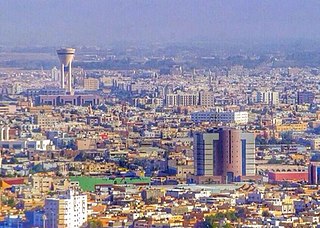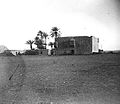
Mecca is the capital of Mecca Province in the Hejaz region of western Saudi Arabia and the holiest city in Islam. It is 70 km (43 mi) inland from Jeddah on the Red Sea, in a narrow valley 277 m (909 ft) above sea level. Its last recorded population was 2,385,509 in 2022. Its metropolitan population in 2022 is 2.4 million, making it the third-most populated city in Saudi Arabia after Riyadh and Jeddah. Around 44.5% of the population are Saudi citizens and around 55.5% are foreigners from other Muslim countries. Pilgrims more than triple the population number every year during the Ḥajj pilgrimage, observed in the twelfth Hijri month of Dhūl-Ḥijjah. With over 10.8 million international visitors in 2023, Mecca was one of the 10 most visited cities in the world.

The Hejaz is a region that includes the majority of the west coast of Saudi Arabia, covering the cities of Mecca, Medina, Jeddah, Tabuk, Yanbu, Taif and Baljurashi. It is thus known as the "Western Province", and it is bordered in the west by the Red Sea, in the north by Jordan, in the east by the Najd, and in the south by the Region of 'Asir. Its largest city is Jeddah, which is the second-largest city in Saudi Arabia, with Mecca and Medina, respectively, being the fourth- and fifth-largest cities in the country.

The Hejaz railway was a narrow-gauge railway that ran from Damascus to Medina, through the Hejaz region of modern day Saudi Arabia, with a branch line to Haifa on the Mediterranean Sea.

Tabuk is the capital city of the Tabuk Region in northwestern Saudi Arabia. It has a population of 594,350. It is close to the Jordan–Saudi Arabia border and houses the largest air force base in Saudi Arabia.

Ma'an is a city in southern Jordan, 218 kilometres (135 mi) southwest of the capital Amman. It serves as the capital of the Ma'an Governorate. Its population was approximately 41,055 in 2015. Civilizations with the name of Ma'an have existed at least since the Nabatean period—the modern city is just northwest of the ancient town. The city is an important transport hub situated on the ancient King's Highway and also on the modern Desert Highway.

Hegra, known to Muslims as Al-Hijr, also known as Mada’in Salih, is an archaeological site located in the area of Al-'Ula within Medina Province in the Hejaz region, Saudi Arabia. A majority of the remains date from the Nabataean Kingdom. The site constitutes the kingdom's southernmost and second largest city after Petra, its capital city. Traces of Lihyanite and Roman occupation before and after the Nabatean rule, respectively, can also be found.

The Vilayet of the Hejaz refers to the Hejaz region of Arabia when it was administered as a first-level province (vilayet) of the Ottoman Empire. At the beginning of the 20th century, it reportedly had an area of 96,500 square miles (250,000 km2). The Hejaz included all land from the southern border of the Vilayet of Syria, south of the city of Ma‛an, to the northern border of the Vilayet of Yemen, north of the city of Al Lith.
Ḥusayn Pasha ibn Ḥasan ibn Aḥmad ibn Riḍwān ibn Muṣṭafā ibn ʿAbd al-Muʿīn Pasha was the Ottoman governor of Gaza Sanjak, a district which extended from Jaffa and Ramla in the north to Bayt Jibrin in the southeast and Rafah in the south, with Gaza as its capital. Husayn belonged to the Ridwan family, who long held the governorship of Gaza. Husayn Pasha became governor in 1644 after succeeding his father 'Arab Hasan Pasha. He served, with a brief interruption by his son Ibrahim in 1660, until his imprisonment in 1662. Husayn Pasha also served intermittent terms as governor of Nablus and Jerusalem and as amir al-hajj. Gaza prospered under Husayn Pasha and its political importance rose so much so that the French consul considered it to be the virtual capital of Palestine. Husayn Pasha maintained friendly relations with the Bedouin tribes of the region, local Christian communities and the French. In 1662, Husayn Pasha was imprisoned by the Ottoman imperial authorities and executed in Damascus later that year or in Constantinople in 1663.
Muzayrib is a town in southern Syria, administratively part of the Daraa Governorate, located northwest of Daraa on the Jordan–Syria border. Nearby localities include al-Shaykh Saad and Nawa to the north, Da'el, Tafas and al-Shaykh Maskin to the northeast, and al-Yadudah to the southeast. According to the Syria Central Bureau of Statistics, Muzayrib had a population of 12,640 in the 2004 census. The town is also the administrative center of the Muzayrib nahiyah (subdistrict) consisting of nine villages with a combined population of 72,625. Muzayrib also has a community of Palestinian refugees.

The Ottoman era in the history of Arabia lasted from 1517 to 1918. The Ottoman degree of control over these lands varied over these four centuries, with the fluctuating strength or weakness of the Empire's central authority.

The hajj is a pilgrimage to Mecca performed by millions of Muslims every year, coming from all over the Muslim world. Its history goes back many centuries. The present pattern of the Islamic Hajj was established by Islamic prophet Muhammad, around 632 CE, who reformed the existing pilgrimage tradition of the pagan Arabs. According to Islamic tradition, the hajj dates from thousands of years earlier, from when Abraham, upon God's command, built the Kaaba. This cubic building is considered the most holy site in Islam and the rituals of the hajj include walking repeatedly around it.

Amir al-hajj was the position and title given to the commander of the annual Hajj pilgrim caravan by successive Muslim empires, from the 7th century until the 20th century. Since the Abbasid period, there were two main caravans, one departing from Damascus and the other from Cairo. Each of the two annual caravans was assigned an amir al-hajj whose main duties were securing funds and provisions for the caravan, and protecting it along the desert route to the Muslim holy cities of Mecca and Medina in the Hejaz.
Husayn Pasha ibn Makki served as the Ottoman wali of Damascus (1757) and Marash (1762), and the sanjak-bey of his native Gaza (1763–1765).
Farrukh Pasha ibn Abdullah was the Ottoman governor of Nablus and Jerusalem in the early 17th century, and founder of the Farrukh dynasty, which held the governorship of Nablus and other posts for much of the 17th century.
The 1757 Hajj caravan raid was the plunder and massacre of the Hajj caravan of 1757 on its return to Damascus from Mecca by Bedouin tribesmen. The caravan was under the protection of an Ottoman force led by the Wali of Damascus, Husayn Pasha, and his deputy Musa Pasha, while the Bedouin were led by Qa'dan al-Fayez of the Bani Sakher tribe. An estimated 20,000 pilgrims were either killed or died of hunger or thirst as a result of the raid.

Dhat al-Hajj is an archaeological site in the Tabuk Province of Saudi Arabia, located north of Tabuk and 16 kilometers (9.9 mi) south of the border with Jordan. Beginning sometime in the Middle Ages, Dhat al-Hajj served as a rest stop and watering place on the Hajj caravan route connecting Egypt and Syria to the Islamic holy cities of Mecca and Medina. The Ottomans fortified the site in the late 16th century. It fell into ruin by the early 18th century and was taken over by Bedouin tribesmen, though it was restored in later decades. The fort is a three-story square structure built around a courtyard and reservoir.

Ash-Sharāt or Ash-Sharāh (Arabic: ٱلشَّرَاة, also known as Bilād ash-Sharāt or Jibāl ash-Sharāt, is a highland region in modern-day southern Jordan and northwestern Saudi Arabia. It was formerly a sub-district in Bilad al-Sham during the 7th–11th centuries CE.

Mudawwara is the most southerly settlement in Jordan. It is administratively part of the Ma'an Governorate. The village had a population of 691 in the 2015 census.

Qasr al-Qatraneh is an Ottoman structure which largely served to provide water and protection on the Syrian pilgrimage route between the Levant and the Gulf. It is located in modern-day Jordan, just off of the country's Desert Highway, approximately 90 kilometres south of Amman and northwest of the town of Qatraneh. It is one of at least ten khans that have been identified and documented along the Syrian pilgrimage route in Jordan.
The sieges of Tiberias occurred in late 1742 and the summer of 1743 when the Ottoman governor of Damascus, Sulayman Pasha al-Azm, twice attempted and failed to eliminate the increasingly powerful, Tiberias-based multazim, Zahir al-Umar, and destroy his fortifications.



















